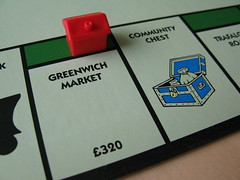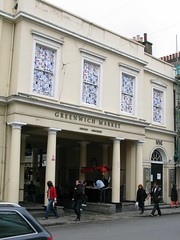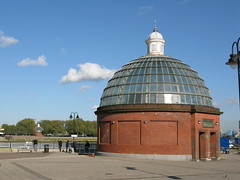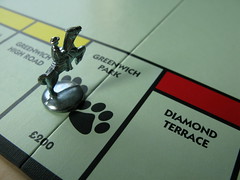AN INFALLIBLE rule for journalists is that the glossier any material, the more worthless its contents. In their battle to pasteurise Greenwich Market, the PRs have over the last eighteen months put out a great deal of glossy paper. Ignore it. The actual, dinstinctly matt-finish, planning application documents are much, much more interesting.
The key document is the Environmental Statement (ES). On your behalf, I spent an afternoon last week reading through its 340 pages, along with all the other documents, available here. I also looked at all the minutes back to 2007 of the ” key stakeholders’ consultation group” (KSCG) set up by the developers. Download those minutes here. Then I read the report produced by Electoral Reform Services (ERS) on the developers’ much-hyped “consultation exercise” – undertaken as long ago as October 2007, incidentally. Download that report here.
Finally, I looked at Greenwich Council’s own statement of its planning policy, the Unitary Development Plan – downloadable here.
And in all this I found some fascinating facts – all there, documented, in black and white – that Greenwich Hospital and its PR allies, such as the Greenwich Society and Nick Raynsford MP, have unfortunately forgotten to tell us. These lead me to the following conclusions.
1. The only way Greenwich Council can pass this application is by totally overriding its own planning policy.
The Unitary Development Plan is quite clear. The market is part of the world heritage site. Policy TC7 states: “The Council will protect and enhance the site and setting of the Maritime Greenwich World Heritage Site…. Development within it should preserve and enhance its essential and unique character and appearance.” Indisputably, the new scheme will not do this.
Policy TC8 states that any new development anywhere in the town centre must “demonstrate the highest standards in design, landscaping, detailing, and finishing.” From the drawings, the design standards of the proposed scheme look distinctly middling and generic.
2. The temporary market proposed during the construction period will involve a big loss of stall and shop space, freezing out some traders entirely and thus probably destroying their businesses. It will also damage the businesses of all traders, since the temporary site proposed is less central, less visible and less likely to be visited than the existing site.
According to the ES, para 3.16, the market stalls area is currently 1456 sq m. There are also 20 shops in the buildings proposed for demolition, of which 18 are tenanted. The temporary market area will be “approximately 1000 sq m” (ES para 3.25) with 6 shops – a reduction of one-third in stall space and two-thirds in the number of shop units.
Some of the 12 displaced shops may be relocatable elsewhere in the Greenwich Hospital estate, but there are currently only 2 vacant shops in the GH estate (outside the market) – and it is hard to imagine that a further 10 vacancies will open up in the next six months.
According to the KSCG minutes, the site proposed for the temporary market is in the north-west corner of the Naval College grounds. This site is somewhat tucked away. Although it is on the route from the pier to the town centre, most visitors arrive by bus, DLR or train, and it is not on the routes between those arrival points and the centre. The site is also blocked from view of the town centre by the Pepys Building and the building site of the Cutty Sark.
3. The permanent market will involve a smaller loss of stall space.
The proposed new permanent market will be 1316 sq m (ES para 3.16) – a reduction of 10% on now. 18 roof support pillars in the middle of the space (rather than at the edges, as now) and the need for a clear walkway for guests to pass between the two halves of the hotel will further reduce stall space.
4. There will be a vast increase in overall build density and floorspace.
The total built footprint on the site will more than double, from 3165 to 7376 sq m (ES para 3.15). The new hotel is now 73% bigger than originally proposed (was 60 rooms in 2007 according to the KSCG minutes, is now 104 rooms.) Far from being a “boutique,” it will be the third largest hotel in the borough.
5. The damaging transport effects of the new hotel have been grossly underestimated. The developers’ assumptions are unrealistic.
The ES (para 13.78-79) claims that the new 104-room hotel, accommodating 200-plus guests when full, will create only 18 extra person movements in the peak hour – surely unrealistic. Still more unrealistic is the claim (ES para 13.78-9) that 16 of those movements would be on foot, to and from public transport. Most guests arriving at or departing 5-star luxury hotels with heavy luggage do not travel by public transport. The coaches, taxis and cars which will bring and collect them will cause significant traffic impact on the busy one-way system – already one of the most congested places in London – because there will be nowhere else for them to stop and load/ unload but right in the middle of the traffic flow. There is also a bus terminus across from the proposed hotel entrance which cannot practicably be relocated, further adding to the lack of road capacity at this point.
All this is contrary to the expressed policy in the UDP (TC12) that the Council “will…seek to reduce the effects of through traffic on Greenwich town centre.”
UDP policy M40 also states that “developments generating/ attracting coach traffic will need to make provision for dropping off and picking up, coach manoeuvring on site.” This is clearly not the case with the proposed hotel. Policy M40 also states that coach traffic may be a reason for refusal of planning permission.
6. The consultation with the public was not as extensive or as supportive as claimed.
The only public consultation event was in October 2007 – more than eighteen months ago. It consisted of an exhbition open for a total of 14 hours across only two days and involving, in any case, a plan substantially different from the one now proposed. The developers’ other efforts (eg newsletters) are examples of “transmit” rather than “receive.”
At the 2007 event, 333 responses were received of which only 79, or 23%, fully supported the scheme and a further 50% raised reservations. (source: ERS report.) Most of the reservations (eg the need to maintain the traditional appearance of the market) have not been adequately addressed in the application – it is therefore wrong to count these individuals as supporters, as the developers do.
Although the official deadline for objections has now closed, councils in practice normally continue to accept objections after the deadline. So it’s probably not too late to object, if you still want to. The email address is david.gittens@greenwich.gov.uk.
PS: I enjoyed the response of Tim Barnes, the Greenwich Society chairman, to my attack on the society in last week’s column. I fear it is a sign of weakness, however, that he had to make something up to support his case. Mr Barnes quotes me as claiming that I am the “voice of Greenwich,” something I have never in fact said or written. I would never be so presumptuous – unlike Mr Barnes, who dismisses concerns about the redevelopment of the market as “not representative” of local people’s views, even though, by his society’s own admission, it has done nothing to ascertain what local people’s views actually are.




